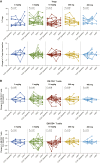First-in-Human Phase I/II Study of INCAGN01876, a Glucocorticoid-Induced Tumor Necrosis Factor Receptor Agonist, in Patients with Advanced or Metastatic Solid Tumors
- PMID: 40711469
- PMCID: PMC12485371
- DOI: 10.1158/1078-0432.CCR-24-4141
First-in-Human Phase I/II Study of INCAGN01876, a Glucocorticoid-Induced Tumor Necrosis Factor Receptor Agonist, in Patients with Advanced or Metastatic Solid Tumors
Abstract
Purpose: Glucocorticoid-induced tumor necrosis factor receptor-related protein (GITR) agonism in T cells may potentiate antitumor immune responses to immune checkpoint blockade therapy. This first-in-human, phase I/II dose escalation/expansion study assessed INCAGN01876, a humanized GITR-targeting agonistic mAb, for advanced solid tumors (NCT02697591).
Patients and methods: Dose was escalated by 0.03 to 20 mg/kg every 2 weeks; flat doses of 400 mg every 4 weeks and 300 mg every 2 weeks were also evaluated. The primary objective was safety/tolerability; secondary objectives were pharmacokinetics and preliminary efficacy; and exploratory objectives were immunogenicity, GITR occupancy, and immune biomarker assessment.
Results: Among 100 patients enrolled [prior anti-PD-1/PD-L1 therapy, 47%; most common tumors: colorectal (19%) and melanoma (14%)], 2% had one dose-limiting toxicity (grade 4 hypoxia and grade 3 pleurisy). The MTD was not reached. Treatment-related adverse events (TRAE) occurred in 69% of patients, most frequently fatigue (17%) and pruritus (14%); 10% had grade ≥3 TRAEs, most commonly fatigue (3%); and 23% reported immune-related adverse events, most frequently generalized pruritus and generalized rash (7% each). Doses ≥5 mg/kg every 2 weeks resulted in full receptor occupancy at trough. INCAGN01876 elicited changes in immune parameters in some patients, including variable peripheral regulatory T-cell depletion and cytokine upregulation. Two patients achieved confirmed partial responses: one with appendiceal mucinous carcinoma and another with melanoma previously treated with pembrolizumab and glembatumumab; 36% of patients had disease control.
Conclusions: INCAGN01876 was generally well tolerated; fatigue was the most frequent TRAE. INCAGN01876 elicited transient and variable regulatory T-cell depletion and limited antitumor activity. Future studies will explore combinatorial approaches.
©2025 The Authors; Published by the American Association for Cancer Research.
Conflict of interest statement
O. Hamid reports other support from Incyte during the conduct of the study as well as research support to institution from Incyte. D.B. Cardin reports grants from Novartis, xBiotech, Elicio Therapeutics, and Arcus Biosciences outside the submitted work. F.S. Hodi reports nonfinancial support from Incyte during the conduct of the study as well as personal fees from Bristol Myers Squibb, Merck, Novartis, Compass Therapeutics, Apricity, Bicara, Checkpoint Therapeutics, BioEntre, Gossamer, Iovance, Catalym, Immunocore, Kairos, Rheos, Bayer, Zumutor, Corner Therapeutics, Puretech, Curis, AstraZeneca, Pliant, Solu Therapeutics, Vir Biotechnology, and 92Bio outside the submitted work. In addition, F.S. Hodi has a patent for Methods for Treating MICA-Related Disorders (#20100111973) pending, licensed, and with royalties paid; a patent for Tumor antigens and uses thereof (#7250291) issued; a patent for Angiopoieten-2 Biomarkers Predictive of Anti-immune checkpoint response (#20170248603) pending; a patent for Compositions and methods for identification, assessment, prevention, and treatment of melanoma using PD-L1 isoforms (#20160340407) pending; a patent for Therapeutic peptides (#20160046716) pending; a patent for Methods of using pembrolizumab and trebananib pending; a patent for Vaccine compositions and methods for restoring NKG2D pathway function against cancers (patent number: 10279021) issued, licensed, and with royalties paid; a patent for Antibodies that bind to MHC class I polypeptide-related sequence A (patent number: 10106611) issued; a patent for Anti-galectin antibody biomarkers predictive of anti-immune checkpoint and anti-angiogenesis responses (publication number: 20170343552) pending; and a patent for Antibodies against EDIL3 and methods of use thereof pending. P. LoRusso reports other support from Takeda, SOTIO, Agenus, Pfizer, GlaxoSmithKline, AstraZeneca, EMD Serono, Kyowa Kirin, Kineta, I-MAB, Compass Therapeutics, MEKanistic, Actuate, Atreca, Amgen, Cullinan, Dren Bio, Quanta Therapeutics, Schrödinger, Boehringer Ingelheim, Prelude, Wells Therapeutics, Zai Lab, Kivu, and Abdera outside the submitted work. T. Merghoub reports grants from Incyte during the conduct of the study. In addition, T. Merghoub has a patent for Anti-GITR antibodies and their methods of use issued; is a consultant for Immunos Therapeutics, Daiichi Sankyo Co, TigaTx, Normunity, and Pfizer and a cofounder of and equity holder in IMVAQ Therapeutics; has received research funding from Surface Oncology, Kyn Therapeutics, Infinity Pharmaceuticals, Peregrine Pharmaceuticals, Adaptive Biotechnologies, Leap Therapeutics, Aprea Therapeutics, and Enterome SA and currently receives research funding from Bristol Myers Squibb and ReAlta Life Sciences; and is an inventor on patent applications related to work on oncolytic viral therapy, alpha virus–based vaccine, neoantigen modeling, immunomodulatory nanoparticles, bispecific activators, FLT3L, CD40, GITR, OX40, PD-1, CTLA-4, and chimeric receptors targeting MUC16, B7H3, and melanoma differentiation antigens. R. Zappasodi reports grants from Bristol Myers Squibb and AstraZeneca during the conduct of the study as well as personal fees from iTeos, Daiichi Sankyo, and Instititute for Follicular Lymphoma Innovation outside the submitted work; in addition, R. Zappasodi has patents for US20180244793A1, US10323091B2, and WO2018106864A1 licensed. J.E. Janik reports other support from Incyte outside the submitted work. M.V.W. van der Velden reports personal fees from Incyte outside the submitted work. J.J. Harding reports personal fees from Amgen, AstraZeneca, Elevar, Exelixis, Eisai, RayzeBio, Servier, Jazz, and Cogent; grants and personal fees from Bristol Myers Squibb and Boehringer Ingelheim; personal fees and other support from Merck; and research support from AbbVie, AstraZeneca, BMS, Boehringer Ingelheim, Eli Lilly, Jazz, Kinnate, Tvardi, and Zymeworks outside the submitted work as well as research support from Incyte related to the submitted work. No disclosures were reported by the other authors.
Figures



References
Publication types
MeSH terms
Substances
Associated data
Grants and funding
LinkOut - more resources
Full Text Sources
Medical
Research Materials

